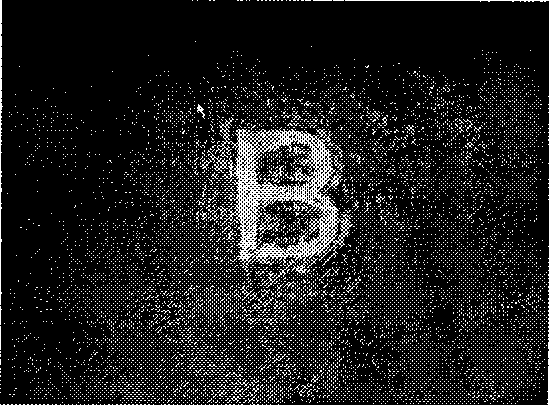Azobenzol liquid crystal holography storage material and preparation method thereof
A storage material and optical holography technology, applied in liquid crystal materials, information storage, recorded information storage and other directions, can solve the problems of easy loss of refractive index modulation of stored information, limited application, etc., achieve good optical properties, simple preparation method, improve The effect of diffraction efficiency
- Summary
- Abstract
- Description
- Claims
- Application Information
AI Technical Summary
Problems solved by technology
Method used
Image
Examples
Embodiment 1
[0031] ①Synthesis of azobenzene unit
[0032] Add p-butoxyaniline (7.8g, 0.05mol) to a solution of 17ml (0.2mol) of concentrated hydrochloric acid and 10ml of water, stir and mix well. Heat with an oil bath to make the solution clear, then quickly put it into an ice-salt bath and stir to obtain good crystals. Keeping the temperature at 0-5°C, sodium nitrite (3.5 g, 0.05 mol) and 20 ml of water were added dropwise with stirring. After 30 min, an equal amount of urea was added to neutralize the remaining sodium nitrite, and the reaction progress was monitored by starch-potassium iodide test paper to obtain a diazonium salt solution. Phenol (4.9 g, 0.05 mol) was dissolved in 10% aqueous sodium hydroxide (4 g, 0.05 mol), and the mixture was cooled to below 10° C. in an ice bath, and then 20 g of ice was added. The above-mentioned diazonium salt solution was slowly added dropwise and stirred rapidly for 1 h, and then a saturated sodium acetate solution was added to adjust the pH ...
Embodiment 2
[0046] ①Synthesis of compounds containing azobenzene and liquid crystal groups
[0047] To 100 ml of dichloromethane were added 4-cyano-4'-carboxybiphenyl (8.3 g, 0.037 mmol), 4,4'-dihydroxyazobenzene (2.6 g, 0.012 mmol) and 4-dimethylaminopyridine (4.5g, 0.037mmol), mix well, pass nitrogen as a protective gas, and then add 1-ethyl-(3-dimethylaminopropyl)carbodiimide hydrochloride (EDC·HCl). After the mixture was stirred at room temperature for 12 h, dichloromethane was added to dilute, and then saturated NH 4 Cl aqueous solution and saturated sodium chloride aqueous solution were washed. The organic layer was dried over anhydrous sodium sulfate, the solvent was evaporated to dryness, and purified by silica gel chromatography to obtain compound 4.
[0048] ② Preparation of optical holographic materials
[0049] Add 2.8 ml of water to γ-glycidyloxypropyltrimethoxysilane (9.4 g, 0.04 mol) and ethyl orthosilicate (2 g, 0.01 mol), and adjust the pH to about 3 with hydrochloric ...
Embodiment 3
[0054] ①Synthesis of azobenzene unit
[0055] p-Methoxyaniline (6.2 g, 0.05 mmol) was added to a solution of 17 ml of concentrated hydrochloric acid (0.2 mol) and 10 ml of water, and stirred to mix well. Heat it with an oil bath to make the solution clear, then quickly put it into an ice-salt bath and stir to get good crystals. Keeping the temperature at 0-5°C, sodium nitrite (3.5 g, 0.05 mol) and 20 mol of water were added dropwise and stirred. After 30 minutes, an equal amount of urea was added to neutralize the remaining sodium nitrite, and the reaction progress was monitored by starch-potassium iodide test paper to obtain a diazonium salt solution. Phenol (4.9 g, 0.05 mol) was dissolved in 10% aqueous sodium hydroxide (4 g, 0.05 mol), and the mixture was cooled to below 10° C. with an ice bath, and then 20 g of ice was added. The above diazonium salt solution was slowly added dropwise, stirred rapidly for 1 h, and then a saturated sodium acetate solution was added to adj...
PUM
| Property | Measurement | Unit |
|---|---|---|
| Photosensitivity | aaaaa | aaaaa |
| Photosensitivity | aaaaa | aaaaa |
| Photosensitivity | aaaaa | aaaaa |
Abstract
Description
Claims
Application Information
 Login to View More
Login to View More - Generate Ideas
- Intellectual Property
- Life Sciences
- Materials
- Tech Scout
- Unparalleled Data Quality
- Higher Quality Content
- 60% Fewer Hallucinations
Browse by: Latest US Patents, China's latest patents, Technical Efficacy Thesaurus, Application Domain, Technology Topic, Popular Technical Reports.
© 2025 PatSnap. All rights reserved.Legal|Privacy policy|Modern Slavery Act Transparency Statement|Sitemap|About US| Contact US: help@patsnap.com



